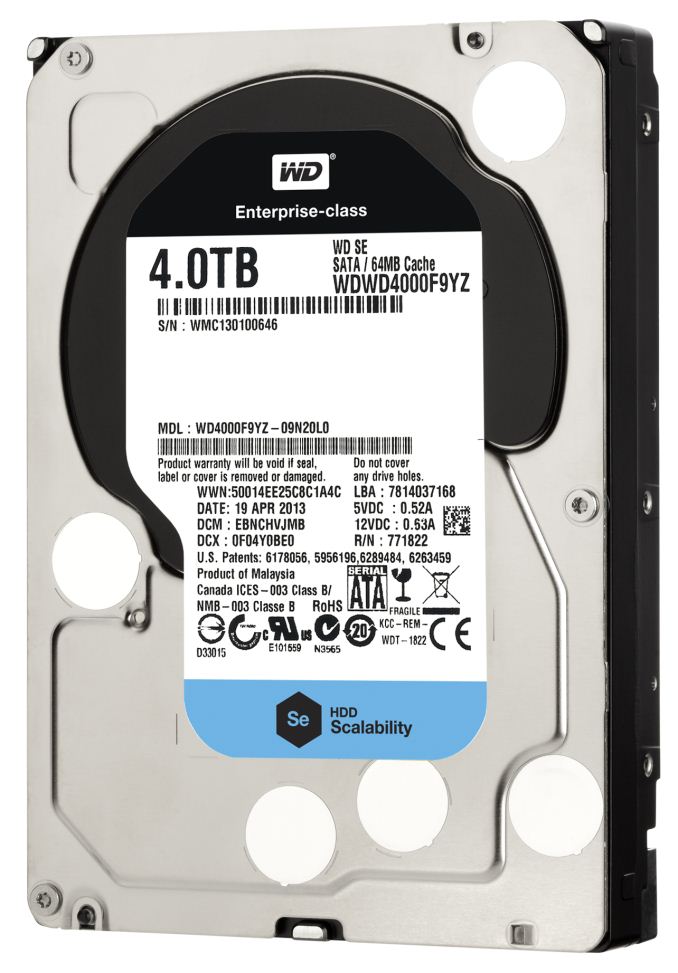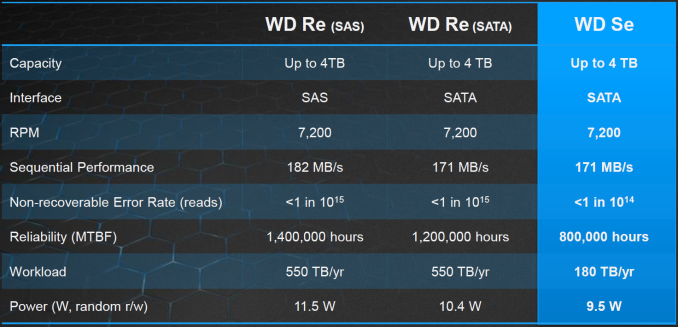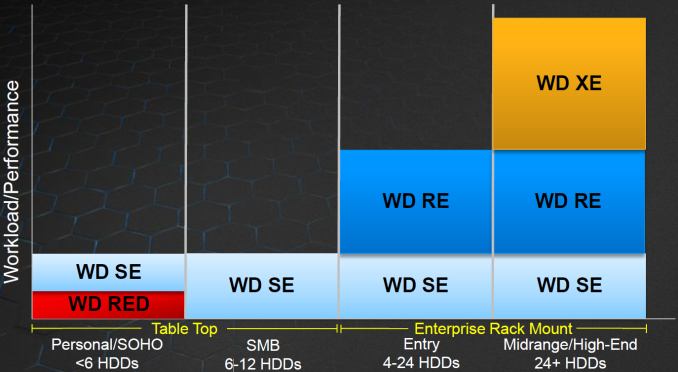Western Digital Launches WD Se Hard Drive Lineup for Datacenters and High-end NAS Units
by Ganesh T S on May 28, 2013 8:00 AM EST- Posted in
- HDDs
- NAS
- Western Digital
- Datacenter
- Enterprise
One of the most interesting launches from Western Digital last year was the WD Red line of hard drives from the client storage division. It was intended for low to mid-range NAS units (and WD wanted to make sure that it wasn't used for units with more than 5 bays). Today, the Datacenter Storage Business Unit is launching the WD Se line intended for high end NAS units and, more importantly, datacenters looking for scalable storage (i.e, reliable storage which doesn't cost an arm and a leg for scenarios where capacity, rather than performance, is of primary importance).
The WD Se line consists of 3.5" 7200rpm Advanced Format SATA drives in 2 TB (WD2000F9YZ), 3 TB (WD3000F9YZ) and 4 TB (WD4000F9YZ) capacities. All of these units have a 64 MB buffer. Pricing ranging from $160 at the low end to $310 at the higher end. Like the WD Re (and, unlike the desktop variants), the WD Se line has a self-encryption option. These drives come with the five year enterprise warranty. Western Digital touts the usage of WD Se drives in their own datacenter (with Apache Hadoop).
WD also advocates use of the WD Se drives in NAS units with 6 to 24 bays in both the desktop as well as rackmount form factors as a complement to the WD Red drives in the lower end units. In the datacenter, WD suggests usage of the WD Re and WD Xe drives for higher durability and performance. Note that the suggested workload for the WD Se is only 180 TB/yr, compared to 550 TB/yr for the WD Re, suggesting that WD is positioning this drive as a solution for backups, archiving and other low intensity tasks. On a comparative basis, the WD Red apparently has a workload rating of less than 100 TB/yr (the client storage division doesn't give out specific numbers) despite coming with a higher MTBF rating (1M hours compared to the 800K for the WD Se).
Some of the features of WD Se include dual processors to maximize performance, RAFF (rotary acceleration feed forward) to monitor and correct vibrations in real time (an issue common in datacenter environments), dual actuator technology to improve positional accuracy of the heads, StableTrac motor shaft securing at both ends to minimize vibrations, multi-axis shocks sensors, RAID-specific TLER (which we covered in the WD Red review) and dynamic fly height technology.













23 Comments
View All Comments
JDG1980 - Wednesday, May 29, 2013 - link
Wouldn't that be easily solved by using decent hard drive bays with anti-vibration grommets, like the ones that come with Fractal Design cases? This is fairly routine in modern enthusiast cases, but for some reason server enclosures are still built like it's 1997.Dentons - Tuesday, May 28, 2013 - link
While Google's comparative hard drive report is now somewhat dated, at the time of their analysis they found little value in enterprise drives. Longevity is the primary, perhaps now the only concern. I'm far from convinced that the features these drives advertise is worth the significant added expense.I wouldn't go so far as to say this is snake oil, but at double the price of consumer drives, there would have to be objective third-party analysis for our group to justify purchasing these, or any other enterprise class drive.
ganeshts - Tuesday, May 28, 2013 - link
Think of it as paying for the extra four years of warranty. If a HDD company is willing to accept returns on the drive for five years instead of the standard one year (on consumer drives), there must at least be some amount of extra stress testing / different technology involved.joel4565 - Tuesday, May 28, 2013 - link
I agree in principle, in practice I am not so sure. As long as hard drive capacities keep increasing, you will probably end up changing them anyway to either increase capacity/decrease number of drives (power, heat, etc).When I started my Unraid server a few years ago 2 TB drives were the norm, now 3 TB are the normal and 4 TB are becoming affordable. So I could either double my capacity or half the number of drives which would reduce the power usage, heat generated, as well as make it quieter.
Dentons - Tuesday, May 28, 2013 - link
Exactly. Also consider that when WD has to replace warranty units, it's typically done many years down the road, and with refurbished stock.So when they charge double for a drive today, it's truly a no lose proposition. Even if they have to replace the drive inside a year, they've charged double, it covers their cost and still permits a profit. A 3TB drive today typically has three platters, in three years, it may be two or even one platter. If the drive lasts two or three years, the decrease in manufacturing costs will see WD profit further.
In all likelihood, a large percentage of units with either last the full five years or if they fail, will not be turned in for warranty replacement. It's on these units where WD makes a stellar profit.
I wouldn't be at all surprised if many big data centers preferred the cheapest drives on offer. Their numbers may tell them that at the mean age of drive failure, it's cheaper to buy a new drive at half the price than pay double upfront (quadruple at mean failure) for a lengthy warranty.
Dentons - Tuesday, May 28, 2013 - link
No, a longer warranty doesn't mean the drives have better longevity. It only means the drive has a longer warranty.This could just be an insurance policy. No one knows actual reliability better than Western Digital. If their actuarial tables line up properly, charging double for the same drive with 5 times the warranty could be a large revenue center for them.
My strong suspicion is that's exactly what's going on here. I suspect these drives are nearly identical to consumer units, and that WD and Seagate are selling thinly disguised insurance policies in the form of their 'higher end' units.
watersb - Tuesday, May 28, 2013 - link
Between 2003-2008 I had to replace about half of my Seagate hard disk collection. They were still on a 5-year warranty. But with 2 or 3-year warranty as standard these days, at a lower price point, I just stay at the 2TB capacity and purchase more drives. The effective cost per drive per year seems to be about the same.Jaybus - Tuesday, May 28, 2013 - link
Not entirely. When you get to larger arrays, PM2/ACPI staggered spin-up support is needed to protect against the power requirements momentarily exceeding the power supply. All drives require more power when spinning up than in operation, so you either have to have a large ps or else staggered spin-up. Desktop drives like the red do not usually support this and other enterprise features such as TLER, etc. needed in larger RAID arrays.But I agree that the difference, aside from the durability guarantees, is entirely firmware related. I get that the extra firmware work makes them more expensive, but NOT twice as expensive.
JDG1980 - Wednesday, May 29, 2013 - link
The WD Red drives do have TLER, so that isn't an issue. As for the spin-up power, maybe if you try to skimp out by getting a crappy 300W no-name power supply, that might be a problem, but I don't see even a dozen hard drives spinning up at once being a problem for a modern 860W Seasonic or Corsair PSU.Dentons - Wednesday, May 29, 2013 - link
You're right. Google uses silicone pads to isolate their hard drives from vibrations in their DIY data centers. Why don't most rack mount server vendors do this? Good question. It's little wonder that Facebook, Microsoft, Amazon, and the others are either already rolling their own solutions, or preparing to.I'm far from convinced that these higher end drives offer any hardware benefit over consumer drives. Different firmware and sometimes longer warranties, but better hardware?
It would be nice to learn what Google and the rest are using in their data centers. My suspicion is that they're using an OEM data center drive that in price and specs, is nearly identical to consumer drives.